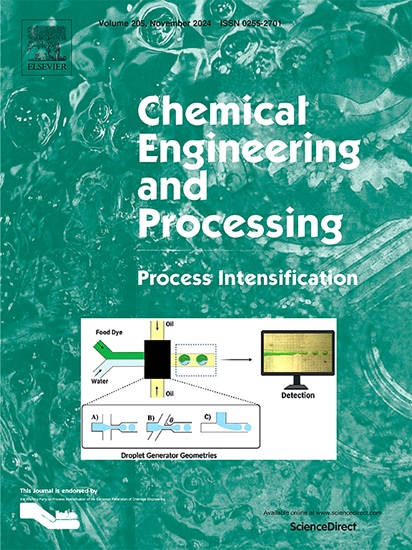Continuous precipitation of nanosized calcium phosphates, including HAp: the role of operating conditions and highly hydrolyzed PVA additive on particles’ characteristics, phase composition, and precipitation kinetics
IF 3.9
3区 工程技术
Q3 ENERGY & FUELS
Chemical Engineering and Processing - Process Intensification
Pub Date : 2025-07-07
DOI:10.1016/j.cep.2025.110436
引用次数: 0
Abstract
The research describes the continuous precipitation of hydroxyapatite nanoparticles from aqueous solutions of (NH4)2HPO4 and Ca(NO3)2, carried out in the Koflo static mixer. The role of a specific turbulence distribution and its intensity, solutions’ concentrations, and the addition of polyvinyl alcohol (PVA) on both the chemical and phase compositions, and final product features have been investigated. The driving force of the process, nucleation sources, and mechanisms controlling particles’ growth have also been determined. It was shown that the shape of HAp particles is primarily influenced by the unit power input εmix and may be changed within petals, whiskers/needles, or spheres. The mean size of single particles varied from 390 to 94 nm, however, agglomeration was observed. Its share was reduced to some extent by i) an increase of εmix and/or ii) the use of a small amount of PVA (up to 2 % w/v). The conditions limiting the formation of other than hydroxyapatite CaP phases (i.e. monetite, brushite), allowing to obtain high purity HAp (≥ 99 %) were defined. As the sources of nuclei, primary heterogeneous nucleation and secondary one were indicated. It was also recognized that the particle growth in the system was controlled by bulk diffusion.

包括HAp在内的纳米磷酸钙的连续沉淀:操作条件和高水解PVA添加剂对颗粒特性、相组成和沉淀动力学的影响
本研究描述了在Koflo静态混合器中从(NH4)2HPO4和Ca(NO3)2水溶液中连续沉淀羟基磷灰石纳米颗粒的过程。研究了特定湍流分布及其强度、溶液浓度和聚乙烯醇(PVA)的加入对化学组成和物相组成以及最终产品特性的影响。确定了该过程的驱动力、成核源和控制颗粒生长的机制。结果表明,HAp粒子的形状主要受单位功率输入ε混合的影响,并可能在花瓣、晶须/针或球体内发生改变。单颗粒的平均粒径为390 ~ 94 nm,但存在团聚现象。它的份额在一定程度上减少了:1)增加ε混合和/或2)使用少量聚乙烯醇(高达2% w/v)。确定了限制形成除羟基磷灰石以外的CaP相(即铁云母、刷石)的条件,从而获得高纯度HAp(≥99%)。作为核的来源,指出了初级非均质成核和次级非均质成核。还认识到体系中的颗粒生长受体扩散控制。
本文章由计算机程序翻译,如有差异,请以英文原文为准。
求助全文
约1分钟内获得全文
求助全文
来源期刊
CiteScore
7.80
自引率
9.30%
发文量
408
审稿时长
49 days
期刊介绍:
Chemical Engineering and Processing: Process Intensification is intended for practicing researchers in industry and academia, working in the field of Process Engineering and related to the subject of Process Intensification.Articles published in the Journal demonstrate how novel discoveries, developments and theories in the field of Process Engineering and in particular Process Intensification may be used for analysis and design of innovative equipment and processing methods with substantially improved sustainability, efficiency and environmental performance.

 求助内容:
求助内容: 应助结果提醒方式:
应助结果提醒方式:


